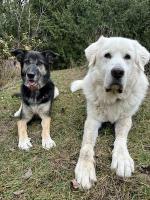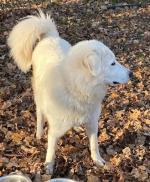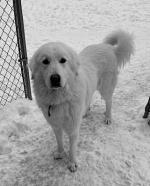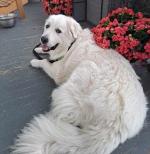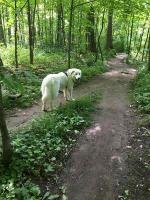Edie (a.k.a. Edelweiss)

*ADOPTED*
We are so happy for Edie. She has found the perfect home with people committed to her for the rest of her life. She has another companion with whom to hang out, as well as other four legged friends. She has acres to walk and a family who loves her.
You can see more photos of her on the GPCSO facebook page.
This is some of her story:
This is sweet Edelweiss, a big white fluffy (we aren't sure what her mix is but she might have some Maremma in her).
She is nine years old and is a big 96 lbs but she needs to lose a little weight. She is looking for a family who will love her and be committed to her for the rest of her life.
Walks and hikes will get her back into shape and probably stop the jumping on furniture behaviour along with some positive-reinforcement training.
She had a bladder infection which has now been treated.
These notes are from her previous people:
CATS: She was around cats until she was four and got along well with them at that time. That probably hasn’t changed. Proper introductions are always required.
DOGS: She has not been around other dogs since moving to Ontario. On walks I noticed other dogs would madly bark at us or/and owners crossing the street to make distance (my guess given her size), but she never ever lunged, pulled, attacked, barked at them. In fact, she ignored it. I would constantly praise her for this.
CHILDREN: She lived with young children in her previous home and she was fine.
PEOPLE: No negative aggression/jumping/barking with visitors at door. She is curious and can be excited to see who it is. Friendly around people.
I have seen her place herself between us and the stranger occasionally when she was suspicious/protective. But never aggressive.
Overall she likes people and is friendly.
FOOD: No aggression around food/eating
BARKING: She does not bark continuously. She is very quiet and well mannered. Not even at knocks at the door. The only time she does is when she wants to go out/be let in. She gives 1 brief "woof" maybe 2.
OTHER: She does not dig or jump/climb fencing. She has wandered if gate was left open and escaped/bolted if spooked.
Recently we noticed smoked detectors scare her. She had escaped twice - both by the alarm.
She is a gentle, kind, friendly, funny dog. Funny..when she gets going..she'll cover her eyes with her paw like peek a boo. She was the best dog we ever had. If it weren’t for the small living space/yard and her inappropriate urinating and jumping /running on furniture (we taught her couch/bed was not for her to be on) we would still have her.
She is very good on a leash and seems to love her walks! She'll need many walks and hikes to help her lose those pounds.
She has some anxiety in the kennel, but as soon as she comes out for a play she settles down and is very curious and friendly.
GPSCOR:
Her anxiety is understandable since she has just come into our care and no doubt misses her former family.
She does have a urinary issue which is being looked into. She panics at the smoke detector and will bolt out the door so care must be taken with her and loud noises.
She loves attention and is very friendly with everyone at the clinic.
Make sure to do your research on any breed in which you are interested.
They are lovely but not a breed for most people. They are great dogs when they come from ethical/reputable breeders, with the crucial socialization and handling by many many different people. They were developed by man to be working dogs. Here is a brief summary of the Pyr:
They are beautiful dogs with great temperaments given the right breeding, socialization, care including diet and training. Dogs are a lifelong commitment.
BARKING: They bark more than most dogs and neighbours do complain. That is a common reason for people surrendering their Pyrs (they didn’t do their research). Their bark is what deters predators and it is instinct to them. That and marking their territory. To take away their bark is to take away who they are. The barking can be managed but it takes time, patience and consistency with positive-reinforcement training. If you don’t like barking, they are not the dog for you.
CONTAINMENT: Pyrs love to hang out outside and their instinct is to wander. Therefore, they require at least a 5-foot secure fence in a large yard in which they can play, run and watch over. Some have been know to scale any height of fencing. No tie outs for these guys. It can lead to aggression since they cannot fully watch over their territory. If they are out all day, as they usually prefer, they need shelter from the elements. And, no electric collars or invisible fencing. If you do not want to fence, this is not the dog for you.
DIGGING: They dig holes in your garden to stay cool in summer so you’ll want to set aside some garden for them.
DIET: Raw is the species-appropriate diet. They eat 2%-3% of the ideal body weight. The breakdown is about 50% edible bone, 35% muscle meat and 5-10% organ meat of beef, chicken, rabbit, deer etc. Do not feed what they are guarding. Start them out on one protein until they are used to it and gradually add another. If you need to feed kibble, ensure it is of high quality and preferably the baked kind. Raw food primer.
DOGS: If you want more than one dog in the home or working, we always recommend two dogs of the opposite sex. Two males or two females do not always see eye-to-eye and fights will ensue in most cases, but not all.
EXERCISE: They require regular walks, of course, so they get out and see the world to keep them interested in life. They must be leashed because they will wander. Again, they have been specifically bred to wander with sheep as they watch over them. It’s suggested to use a front lead harness which will cut down on any damage to the spine should the dog pull although, with a little training, they will be good on a leash. If you don't want to get out there and hike/walk your dog, this is not the dog for you.
GROOMING: Working and companion dogs must be groomed. They require a good weekly grooming to keep them mat free and their skin healthy (hence, pain free from the pulling of mats as they move), and cutting their nails including their dew claws every couple of weeks to a month. NEVER have their dew claws removed. This is a barbaric practice. Simply keep the dews trimmed.
They molt twice a year and shed all year round so your vacuum stays full. NEVER shave a Pyr. Their coats keep them cool in summer–they lose their undercoat, leaving just guard hairs–the guard hairs protect your dog from sunburn and insulate him against heat, as well as allowing air to circulate to keep the skin cool–and warm in winter–their undercoat grows close to the skin to keep your dog warm and dry. This system only works if you groom your dog regularly. If you don’t like grooming, take your dog to a master groomer. If you don’t want to groom your dog, this isn’t the dog for you.
TRAINING: They require a lot of socialization as pups onward with people and other dogs. They also require positive-reinforcement training (a trainer who shows you how to work with a clicker). Pyrs, nor any dogs, take kindly to any kind of punishment. Always use positive-reinforcement training. It will lead to aggression. Dr. Sophia Yin and Susan Garrett are great website resources.
It’s important to work with dogs as if in a dance and you are leading. Rewards for good behaviour and redirect for unwanted behaviour. It’s up to you to make them a good canine citizen. When engaging a trainer, ensure they use positive-reinforcement training to show you how to manage your dog. Never send a dog away for training. You are the one working with the dog, not a trainer. If you are not ready to train a dog, this is not the dog for you.
To train a Pyr is not like training some other breeds. They are not eager-to-please and just as soon walk away from you than do as you say. They were bred by man to be used as guardian livestock dogs because they do not require human intervention to tell them how to do their job. Lots of patience, consistency and time is required to work with them. If you want an obedient dog, this is not the dog for you.
TRAINING FOR LIVESTOCK: There are a few who just want to be a companion dog. Most are natural guardian dogs of livestock. Yes, it is instinct. However, you must introduce your dog to any livestock slowly. This means leashing your dog to you as you work about the animals and barns so they get used to them. When you are not there, keep them safely away from the animals yet still in sight of them. Fowl can be difficult for dogs because of how they move but it can be done. It will take at least a month for a Pyr to get used to the animals, maybe less. You’ll know when they are ready, and the dog will take it from there.
WHY ARE THEY SURRENDERED: There are those in need of a home because someone didn’t realize they would get so big, bark so much (complaints from neighbours), leave so much hair in the house, wander, and require work. There are those families having a baby and don't want their dog, anymore. There are also those whom people want to surrender for aggression but we do not take those dogs in. These dogs usually come from farmers, backyard breeders and pet shops (puppy mills) where genetics are unknown by the ‘breeders’. Combine this with lack of socialization and handling by many many different people in the crucial first thirteen weeks of their lives, and by the time they start to mature, aggression can set in.
Comments for Edie (a.k.a. Edelweiss)
|
||
|
||
|
||
|
||
|
||
|
||
|
||
Breaking News
-
Courtesy - Bear
Apr 09, 25 09:09 AM
Bear DOB: October 2018 Location: Midland, Ontario Pyr/Maremma? mix Single family home with a large securely-fenced property or a hobby farm. Purchased/adopted -
Courtesy Post - Willow
Apr 09, 25 09:07 AM
DOB: March 26th, 2022 Location: London Ontario Cross Pyr/Collie Obtained her privately through a friend. How long have you had her? 10 months Spayed -
Lucy
Apr 09, 25 09:06 AM
*Foster-to-Adopt* or *Foster* DOB: January 3, 2024 Location: Acton, Ontario She will need a single-family home with a securely fenced yard of at least -
Remi
Apr 09, 25 07:44 AM
Location: Acton, Ontario DOB: February 2024 This sweet white fluffy Remi has a sad story. Remi, while his family was in the midst of moving, escaped and -
Grieving Dog
Apr 04, 25 06:17 PM
Background: I am seeking some feedback if anyone has had experience with bonded pairs. Thank you! We have been fortunate to love 2 x almost 10 year -
Leo
Mar 12, 25 06:32 AM
*ADOPTED* DOB: September 2023 (almost 1.5-years-old) Location: Acton, ON Single family home with a securely fenced yard required. This sweetheart was -
Buster
Mar 10, 25 03:36 PM
*Buster is going back to his original family as things have brightened up in their lives and he'll have a wonderful life on acreage.* Buster had to come -
Courtesy - Maya
Jan 08, 25 05:35 PM
*ADOPTED* Location: Dunnville, ON DOB: Jan. 3, 2021 (3.5 years) Spayed Companion Dog, Pyr mix Good with children. Single family home. Raw diet (species-appropriate)












